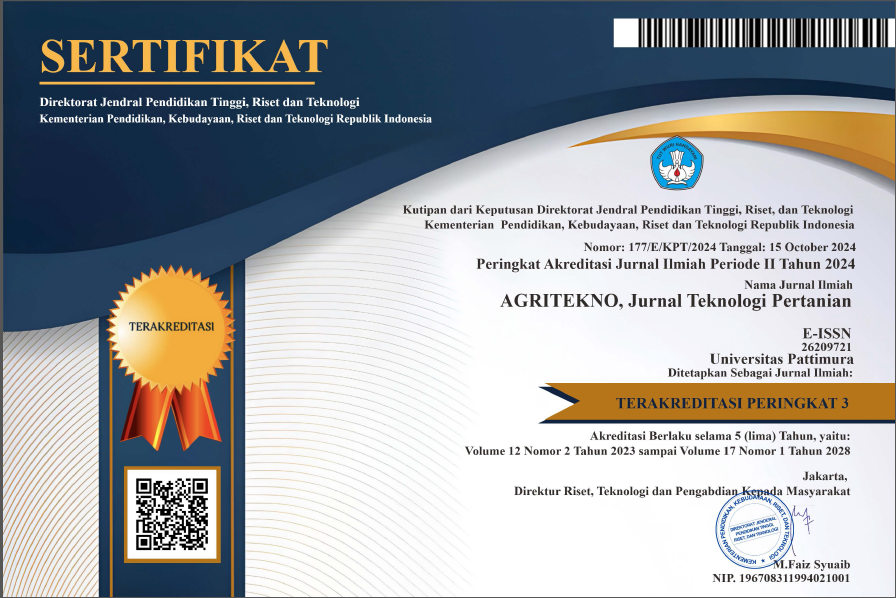Kandungan Mioglobin dan Warna pada Ikan Tuna (Thunnus albacares) Loin yang Diaplikasi dengan Gas Non Kondensat
Myoglobin Content and Color of Tuna (Thunnus albacares) Loins Treated with Non-Condensate Gas Applications
Abstract
The use of carbon monoxide gas in handling export-quality tuna loins gas has been prohibited by the FDA due to its residual effects. As an alternative, filtered smoke derived from the combustion of hardwood has been proposed. However, this gas is expensive and primarily produced in Hawaii. During the production of liquid smoke, a non-condensable gas is generated that contains carbon monoxide and may serve to preserve quality, including color and myoglobin content. The aim of this research was to identify the components of non-condensable gas and evaluate its application on tuna loins. A descriptive method was employed, and the data were presented in images and tables. The materials used included sago waste (waa sagu) and tuna loins (Thunnus albacares). Observations involved analyzing the composition of the non-condensable gas from sago waste, as well as changes in color and myoglobin content of tuna loins treated with the gas. The analysis identified 12 components in the non-condensable gas, including nitrogen and carbon monoxide. Tuna loins treated with this gas maintained a red color and a myoglobin content of 49.31±0.70 mg %.
Downloads
References
Abustam, E., Said, M., Yusuf, M., & Ali, H.M. (2019). Effect of aging time on changes in smoke flour compounds on meatballs and fresh meat of Bali beef. IOP Conference Series: Earth and Environment, 247, 012026. https://doi.org/10.1088/1755-1315/247/1/012026
Álvarez-Armenta, A., Huerta‐Ocampo, J., López-Zavala, A., Pacheco-Aguilar, R., Sotelo-Mundo, R., Corona-Martínez, D.O., & Ramírez-Suárez, J.C. (2023). Review of the greening reaction by thermal treatment: New insights exploring the structural implications of myoglobin. Journal of Agricultural and Food Chemistry, 71(46), 17485–17493. https://doi.org/10.1021/acs.jafc.3c02109
Ariyani, F., Kristiningrum, E., Barokah, G., & Januar, H. (2020). The effects of carbon monoxide treatment on the physical and chemical qualities of tuna steak during iced storage. Squalen Bulletin of Marine and Fisheries Postharvest and Biotechnology, 15(2), 73-79. https://doi.org/10.15578/squalen.456
Astagia, A., Nurani, T., & Kurniawati, V. (2022). Persyaratan ekspor tuna tujuan Uni Eropa, Amerika Serikat, dan Jepang. ALBACORE Jurnal Penelitian Perikanan Laut, 6(1), 57-66. https://doi.org/10.29244/core.6.1.057-066
Badan Pusat Statistik. (2023) Ekspor Ikan Segar/Dingin Hasil Tangkapan Menurut Negara Tujuan Utama 2012-2023. BPS.
Bu, Y., Han, M., Tan, G., Zhu, W., Li, X., & Li, J. (2021). Changes in quality characteristics of southern bluefin tuna (Thunnus maccoyii) during refrigerated storage and their correlation with color stability. LWT, 154, 112715. https://doi.org/10.1016/j.lwt.2021.112715
Chamorro, F., Cassani, L., García-Oliveira, P., Barral-Martinez, M., Jorge, A.O.S., Pereira, A., Otero, P., Fraga-Corral, M., Beatriz, M., Oliveira, P.P., Prieto, M.A., Dufossé, L., & Ameer, K. (2024). Health benefits of bluefin tuna consumption: (Thunnus thynnus) as a case study. Frontiers in Nutrition, 11, 1340121. https://doi.org/10.3389/fnut.2024.1340121
Fitria, Y., Yusra, Suparno, Arlius, & Munzir, A. (2024). Quality control through the implementation of HACCP in the process of frozen tuna loin processing at PT. Lintas Laut Samudera, Bungus, West Sumatra. International Journal of Progressive Sciences and Technologies, 46(2), 126-133. http://dx.doi.org/10.52155/ijpsat.v46.2.6565
Hahn, M.J. (1999). Use of Tasteless Smoke. Washington, D.C.: Hawaii International Seafood, Inc.
Mutamima, A., Sunarno, Al'farisi, C.D., Dewi, W.N., Trisno, A., & Barus, S.D.A. (2025). Physicochemical characterization of coconut shell liquid smoke and its potential as a natural preservative for fish balls. Jurnal Ilmiah Pertanian, 22(1), 13-22. https://doi.org/10.31849/jip.v22i1.23850
Jo, D-M., Song, M., Park, S-K., Choi, J., Oh, D.K., Kim, D-H., & Kim, Y-M. (2023). Potential application of lactic acid bacteria for controlling discoloration in tuna (Thunnus orientalis). Food Bioscience, 54, 102856. https://doi.org/10.1016/j.fbio.2023.102856
Kristinsson, H.G., Mony, S., Demir, N., Balaban, M.O. & Otwell, W.S. (2008). The effect of carbon monoxide and filtered smoke on the properties of aquatic muscle and selected muscle components. Taft 2003. Proceedings of the TAFT 2003 Conference. Reykjavik. Iceland: pp. 27-29.
Loppies, C.R.M., Apituley, D.A.N., Sormin, R.B.D., & Setha, B. (2021). Kandungan mioglobin ikan Tuna (Thunus albacares) dengan pemakaian karbon monoksida dan filter smoke selama penyimpanan beku. Jurnal Inasua, Teknologi Hasil Perikanan, 1(1).
Mahaliyana, A.S., Jinadasa, B., Liyanage, N.P., Jayasinghe, G., & Jayamanne, S.C. (2015). Nutritional composition of Skipjack Tuna (Katsuwonus pelamis) caught from the Oceanic Waters around Sri Lankae. American Journal of Food and Nutrition, 3, 106-111.
Nakazawa, N., Wada, R., Fukushima, H., Tanaka, R., Kono, S., & Okazaki, E. (2020). Effect of long-term storage, ultra-low temperature, and freshness on the quality characteristics of frozen tuna meat. International Journal of Refrigeration, 112, 270-280. https://doi.org/10.1016/j.ijrefrig.2019.12.012
Neethling, N.E., Hoffman, L., Britz, T.J., & O’Neill, B. (2015). Influence of carbon monoxide on the colour stability of defrosted yellowfin tuna (Thunnus albacares) muscle stored under aerobic and anaerobic conditions. Journal of the Science of Food and Agriculture, 95(8), 1605-1612. https://doi.org/10.1002/jsfa.6991
Nurilmala, M., Ushio, H., Kaneko, G., & Ochiai, Y. (2013). Assessment of commercial quality evaluation of yellowfin Tuna (Thunus albacores) meat based on myoglobin properties. Food Science and Technology Research, 19(2), 237-243. https://doi.org/10.3136/fstr.19.237
Pezeshk, S., Ojagh, S. M., & Alishahi, A. (2016). Effect of plant antioxidant and antimicrobial compounds on the shelf-life of seafood - A review. Czech Journal of Food Science, 33(3), 195-203. https://doi.org/10.17221/593/2014-CJFS
Pujol, A., Ospina‐E, J.C., Alvarez, H., & Muñoz, D.A. (2023). Myoglobin content and oxidative status to understand meat products’ color: Phenomenological based model. Journal of Food Engineering, 348, 111439. https://doi.org/10.1016/j.jfoodeng.2023.111439
Pivarnik, L.F., Faustman, C., Rossi, S., Suman, S.P., Palmer, C., Richard, N.L., Ellis, P.C., & DiLiberti, M. (2011). Quality assessment of filtered smoked yellowfin tuna (Thunnus albacares) steaks. Journal of Food Science, 76(6), S369-S379. https://doi.org/10.1111/j.1750-3841.2011.02276.x
Rokhman, B., Kobzar, S.G., & Chetveryk, H. (2024). Study on kinetics of biomass pyrolysis in the fixed bed. 2. Analysis of the results of calculating the thermal decomposition of different types of solid fuel. Energy Technologies & Resource Saving, 96-109. https://doi.org/10.33070/etars.2.2024.07
Sakowska, A., Guzek, D., Głąbska, D., & Wierzbicka, A. (2016). Carbon monoxide concentration and exposure time effects on the depth of CO penetration and surface color of raw and cooked beef longissimus lumborum steaks. Meat Science, 121, 182-188. https://doi.org/10.1016/j.meatsci.2016.06.013
Sari, E., Khatab, U., Burmawi, Rahman, E.D., Afriza, F., Maulidita, A., & Desti, V. (2019). Production of liquid smoke from the process of carbonization of durian skin biomass, coconut shell and palm shell for preservation of tilapia fish. IOP Conference Series: Materials Science and Engineering, 543, 012075. https://doi.org/10.1088/1757-899X/543/1/012075
Sieradzka, M., Gao, N., Quan, C., Mlonka-Mędrala, A., & Magdziarz, A. (2020). Biomass thermochemical conversion via pyrolysis with integrated CO2 capture energies. XXIV International Symposium on Combustion Processes, September 23-25, 2019, Wroclaw, Poland. https://doi.org/10.3390/en13051050
Singh, A., Mittal, A., & Benjakul, S. (2021). Undesirable discoloration in edible fish muscle: Impact of indigenous pigments, chemical reactions, processing, and its prevention. Comprehensive Reviews in Food Science and Food Safety, 21(1), 580-603. https://doi.org/10.1111%2F1541-4337.12866
Sika, A.E., Aké-Assi, Y., Anoman, T., Kambire, O., Koffi-Nevry, R., & Djé, K. (2020). Effect of lactic acid on inactivation of enterotoxigenic Escherichia coli (ETEC) isolated from tuna loins produced in Côte D’Ivoire. Journal of Advances in Microbiology, 20(4), 41–50. https://doi.org/10.9734/jamb/2020/v20i430235
Sispaditanianggi, L. (2017). Perancangan Mesin Penggiling Ikan Tuna Untuk Bahan Baku Pembuatan Nugget Dengan Kapasitas 60 kg/jam. Skripsi. Malang: Universitas Muhammadiyah Malang.
Trisnaningsih, D. (2014). Kadar Protein Dan Betakaroten Bakso Ikan Tuna Yang Diperkaya Jamur Merang (Volvariella volvaceae) Dan Umbi Wortel. Skripsi. Fakultas Keguruan Dan Ilmu Pendidikan, Universitas Muhammadiyah Surakarta, Surakarta. https://eprints.ums.ac.id/28728/
Wang, B., Wang, S., Xu, Y., Jiang, Q., & Xia, W. (2024). Colour stability improving of yellowfin tuna slices by compound antioxidant against oxidation of myoglobin. International Journal of Food Science and Technology, 59(8), 5616–5629. https://doi.org/10.1111/ijfs.17285
Wodi, S.I.M., Trilaksani, W., & Nurilmala, M. (2014). Perubahan mioglobin tuna mata besar selama penyimpanan suhu chilling. JPHPI, 17(3).
Copyright (c) 2025 The Author(s)

This work is licensed under a Creative Commons Attribution-ShareAlike 4.0 International License.
Authors who publish with this journal agree to the following terms:
- Authors retain copyright and grant the journal the right of first publication with the work simultaneously licensed under a Creative Commons Attribution License that allows others to share the work with an acknowledgement of the work's authorship and initial publication in this journal.
- Authors are able to enter into separate, additional contractual arrangements for the non-exclusive distribution of the journal's published version of the work (e.g., post it to an institutional repository or publish it in a book), with an acknowledgement of its initial publication in this journal.
- Authors are permitted and encouraged to post their work online (e.g., in institutional repositories or on their website) prior to and during the submission process, as it can lead to productive exchanges, as well as earlier and greater citation of published work (See The Effect of Open Access).









